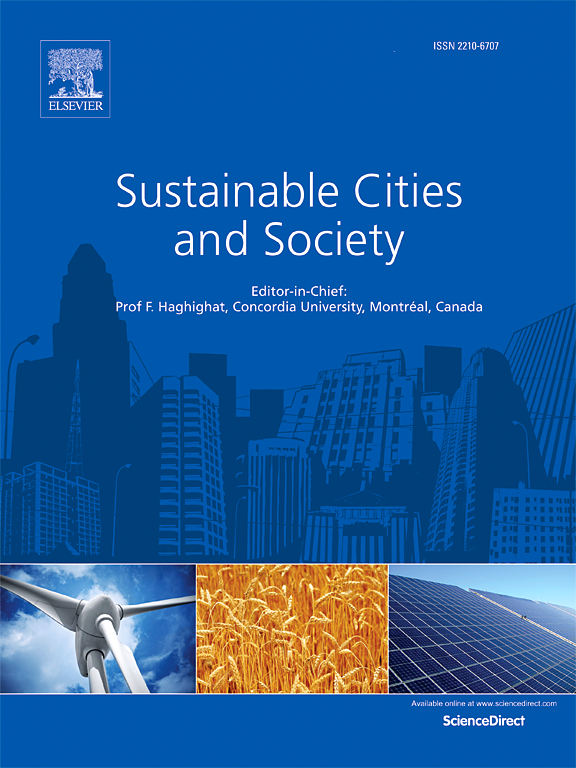Spatial heterogeneity, interaction and multi-scale effects of driving factors of heat island intensity in different urban agglomerations
IF 10.5
1区 工程技术
Q1 CONSTRUCTION & BUILDING TECHNOLOGY
引用次数: 0
Abstract
Quantifying the spatial heterogeneity of Surface Urban Heat Island (SUHI) and its driving mechanisms is essential for proposing sustainable heat mitigation measures. However, the spatial relationship between various factors and SUHI across different urban agglomerations, as well as the synergistic effects of multiple factors on it, remain unclear. This study analyzes SUHI patterns and their drivers from the perspectives of spatial heterogeneity, interaction and multi-scale effects of driving factors across three urban agglomerations (urban agglomeration of Chengdu-Chongqing (UACC), the Yangtze River middle reaches (UAYZMR), and the Yangtze River delta (UAYZD)) in China with multiscale geographically weighted regression and optimal parameter geographical detector. The results included: (1) Distinct dominant drivers across regions—UACC exhibited strongest elevation control (q = 0.73) coupled with artificial lighting impacts, UAYZMR showed balanced vegetation-elevation interactions (q = 0.35), while UAYZD demonstrated comparable vegetation and urbanization influences (q = 0.37). (2) Strong interaction effects existed between factors, with SUHIs in UACC and UAYZMR primarily influenced by vegetation-terrain interactions, while SUHIs in UAYZD were driven by vegetation-urbanization interactions. (3) Scale-dependent spatial heterogeneity in both direction and intensity of driving forces. These findings advocate for differentiated urban planning: prioritizing terrain-adaptive designs in mountainous cities, large-scale green infrastructure in transitional zones, and compact green-blue networks in coastal megacities. This study provides a transferable framework for developing spatially-tailored and sustainable heat resilience strategies across diverse urban contexts.
不同城市群热岛强度驱动因素的空间异质性、相互作用及多尺度效应
量化城市地表热岛的空间异质性及其驱动机制对于提出可持续的热缓解措施至关重要。然而,不同城市群间各因素与SUHI之间的空间关系以及多因素对SUHI的协同效应尚不清楚。利用多尺度地理加权回归和最优参数地理探测器,从成渝城市群、长江中游城市群和长江三角洲城市群的空间异质性、相互作用和驱动因素的多尺度效应角度,分析了中国城市SUHI格局及其驱动因素。结果表明:(1)各区域主导驱动因素明显,uacc表现出最强的高程控制(q = 0.73)和人工照明影响,UAYZMR表现出平衡的植被-高程相互作用(q = 0.35),而UAYZD表现出相当的植被和城市化影响(q = 0.37)。(2)因子间存在较强的交互作用,UACC和UAYZMR的SUHIs主要受植被-地形交互作用的影响,而UAYZD的SUHIs主要受植被-城市化交互作用的驱动。(3)驱动力方向和强度的空间尺度依赖性异质性。这些发现提倡差异化的城市规划:在山区城市优先考虑地形适应性设计,在过渡地区优先考虑大规模绿色基础设施,在沿海特大城市优先考虑紧凑的绿蓝网络。本研究提供了一个可转移的框架,用于在不同的城市环境中制定空间定制和可持续的热恢复策略。
本文章由计算机程序翻译,如有差异,请以英文原文为准。
求助全文
约1分钟内获得全文
求助全文
来源期刊

Sustainable Cities and Society
Social Sciences-Geography, Planning and Development
CiteScore
22.00
自引率
13.70%
发文量
810
审稿时长
27 days
期刊介绍:
Sustainable Cities and Society (SCS) is an international journal that focuses on fundamental and applied research to promote environmentally sustainable and socially resilient cities. The journal welcomes cross-cutting, multi-disciplinary research in various areas, including:
1. Smart cities and resilient environments;
2. Alternative/clean energy sources, energy distribution, distributed energy generation, and energy demand reduction/management;
3. Monitoring and improving air quality in built environment and cities (e.g., healthy built environment and air quality management);
4. Energy efficient, low/zero carbon, and green buildings/communities;
5. Climate change mitigation and adaptation in urban environments;
6. Green infrastructure and BMPs;
7. Environmental Footprint accounting and management;
8. Urban agriculture and forestry;
9. ICT, smart grid and intelligent infrastructure;
10. Urban design/planning, regulations, legislation, certification, economics, and policy;
11. Social aspects, impacts and resiliency of cities;
12. Behavior monitoring, analysis and change within urban communities;
13. Health monitoring and improvement;
14. Nexus issues related to sustainable cities and societies;
15. Smart city governance;
16. Decision Support Systems for trade-off and uncertainty analysis for improved management of cities and society;
17. Big data, machine learning, and artificial intelligence applications and case studies;
18. Critical infrastructure protection, including security, privacy, forensics, and reliability issues of cyber-physical systems.
19. Water footprint reduction and urban water distribution, harvesting, treatment, reuse and management;
20. Waste reduction and recycling;
21. Wastewater collection, treatment and recycling;
22. Smart, clean and healthy transportation systems and infrastructure;
 求助内容:
求助内容: 应助结果提醒方式:
应助结果提醒方式:


